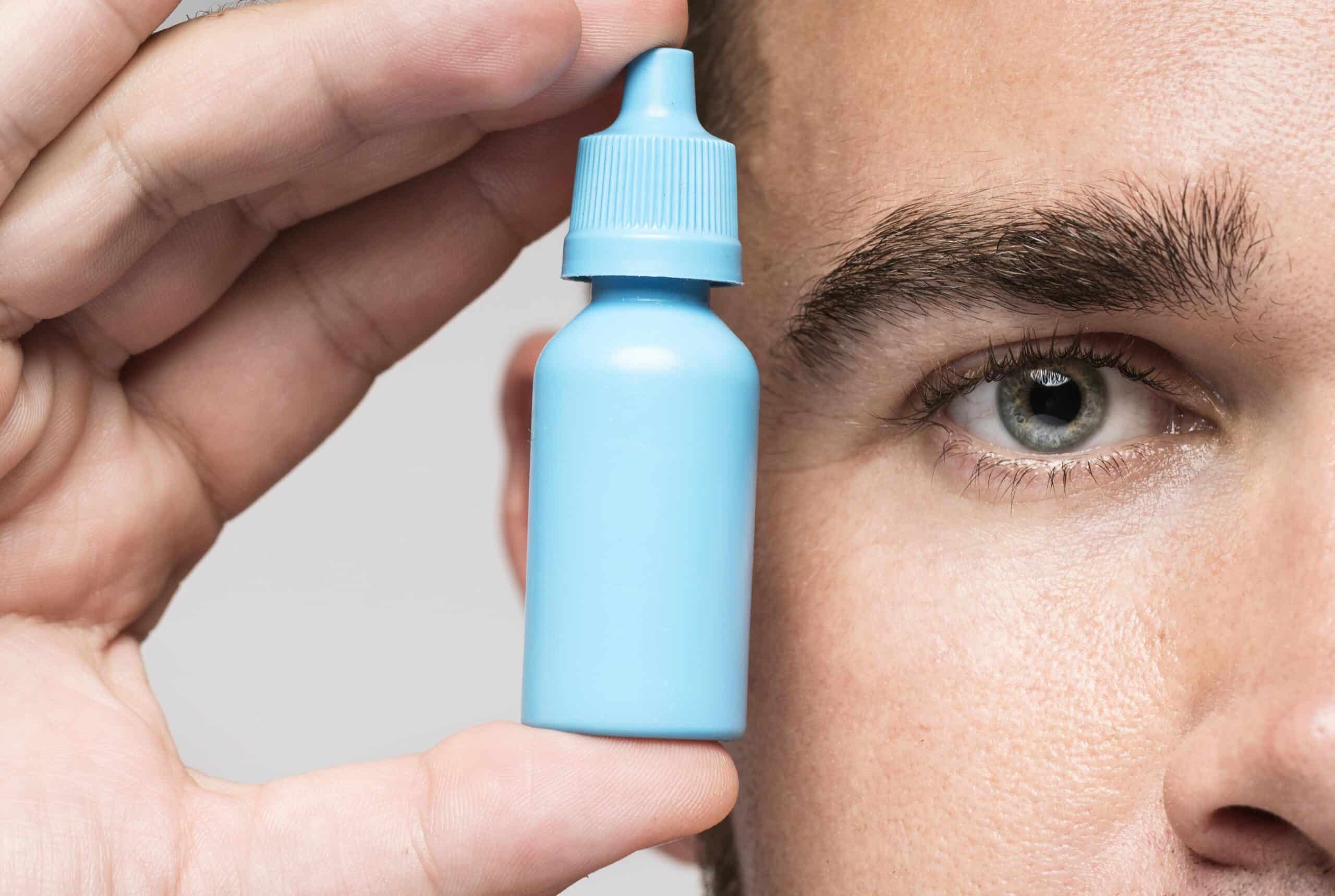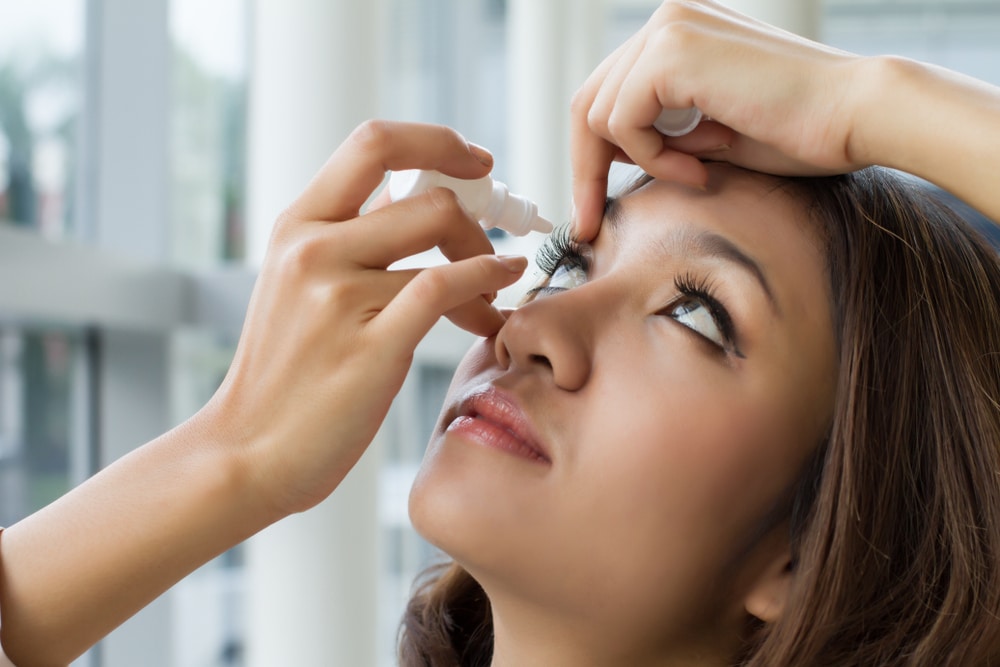Lubricant eye drops, also known as artificial tears, are considered a common over-the-counter product. It is used to relieve dry, irritated eyes. These drops contain a variety of ingredients that help to replenish and mimic the natural tear film layer on the eye’s surface. This layer protects the eye from external irritants and keeps the eye lubricated and moist.
Dry eyes may result from factors like air conditioning or extended screen use. This leads to discomfort due to environmental conditions. Certain medical conditions, medications, and aging can also cause dryness in the eyes. Symptoms of dry eyes may include burning, itching, redness, and blurred vision.
The best preservative-free lubricating eye drops will provide temporary relief from these symptoms and help to improve the health of the eye. They are available in preservative-free to thicker gels and ointments for more severe dry eye conditions.
It is important to note that not all formulations of eye drops in lubricant forms are suitable for all individuals. Those with certain allergies or sensitivities may need to avoid certain ingredients. It is also important to follow the instructions on the packaging for appropriate dosing and timing. If symptoms persist or worsen, the recommendation is to seek advice from an eye care professional.
How Often Should I Use Lubricant Eye Drop?
The frequency of using the best lubricant eye drops depends on several factors. The factors include the cause and severity of your dry eyes, the type of eye drops you use, and your doctor’s recommendation. Generally, if you have mild to moderate dry eyes, you can use these eye drops as often as necessary to relieve the symptoms. Yet, if you have severe dry eyes, you may need to use drops every few hours or even more.
It is necessary to follow the instructions on the label of the eye drops or the recommendation of your doctor. It will help to avoid overusing or underusing the drops. Using too many drops can lead to blurred vision, redness, and irritation. Besides, less usage will result in inadequate relief of the dryness.
If you are unsure about how often you should use eye drops lubricant, consult your eye doctor for guidance. They can assess your dry eye condition and recommend a suitable treatment plan that includes the optimal frequency of using eye drops.
How Do Eye Drops Lubricant Work?
The top rated lubricating eye drops work by adding artificial tears to your eyes, which help to lubricate and hydrate the ocular surface. It contains ingredients that mimic the natural tear film, such as electrolytes, minerals, and lubricants.
When you apply eye drops, they spread over your eye’s surface, coating it with a thin layer of moisture. This helps to reduce friction between the eyelid and the eye and prevent the evaporation of natural tears, which can lead to dry eyes.
Some eye drops have preservatives that help in preventing bacterial contamination and prolong the shelf life of the drops. Yet, some people may be sensitive to the preservatives and experience irritation or allergic reactions.
Can I Use Lubricant Eye Drop With Contacts?
Yes, you can use best preservative free lubricating eye drops with contact lenses. Using eye drops can help to relieve contact lens-related dryness and irritation.
When choosing eye drops for lubricant to use with your contacts, look for drops designed for use with contacts. These drops tend to be less viscous than regular drops, making them easier to apply with lenses.
It is necessary to follow the instructions on using eye drops with contacts to avoid damaging or dislodging the lenses. Most eye drops require removing the lenses before applying the drops and waiting for a few minutes before reinserting them.
If you experience persistent discomfort or dryness with your contact lenses, consult your eye doctor for a proper evaluation and treatment plan.

What Are The Side Effects Of Lubricant Eye Drop?
Eye drops in Lubricant form, are generally safe and well-tolerated, but like any medication, they can cause side effects in some people. The most common side effects of these eye drops include:
– Blurred vision
– Redness or irritation
– Watery eyes
– Foreign body sensation
– Stinging or burning sensation
– Allergic reactions
Some top rated lubricating eye drops have preservatives causing allergic reactions or sensitivity in some users. If you experience any of these side effects or any other unusual symptoms after using the eye drops, stop using them and consult your doctor.
What Is The Best Lubricant Eye Drop For Dry Eyes?
The best preservative free lubricating eye drops for dry eyes depend on your individual needs and preferences. There are several types of eye drops in lubricant form available, including:
– Artificial tears: These are the most common types and contain a mix of electrolytes and lubricants to mimic the composition of natural tears.
–Gel drops: These are more viscous than artificial tears and provide longer-lasting relief for moderate to severe dry eyes.
– Ointments: These are the thickest type of eye drops and are utilized at night to provide extended relief and prevent dryness during sleep.
– Preservative-free eye drops: These eye drops do not contain preservatives and are suitable for people with sensitive eyes or those who need to use eye drops.
It is important to choose a lubricant eye drop that matches your specific dry eye condition and addresses your symptoms. Consult your eye doctor for a proper evaluation and recommendation of the best eye drops for your needs.
How Long Does Lubricant Eye Drop Last?
The duration of which these lubricants effects depends on the type of eye drops you use and the severity of your dry eyes. Artificial tears tend to last for about 1-2 hours and must be applied several times a day.
Gel drops and ointments provide longer-lasting relief, with effects lasting up to 4-6 hours or even more. Yet, they may also cause temporary blurred vision or greasy vision, which can affect your vision quality.
It is fundamental to follow the instructions on the package label or your doctor’s recommendation. This will allow you to follow the optimal frequency of using eye drops to avoid overusing or underusing the drops.
How Do I Use Lubricant Eye Drop?
To use eye drops lubricant, follow these steps:
- Wash your hands with soap and water.
- Shake the eye drop bottle well before use.
- Tilt your head back and look up.
- Pull down your lower eyelid with your index finger to form a pocket.
- Hold the dropper close to your eye, but not touching it, and squeeze one or two drops into the pocket.
- Blink a few times to distribute the drops over the eye.
- Wipe away any excess drops with a tissue.
- Repeat the process if necessary.
It is important to avoid touching the dropper tip with your fingers or any other surface to avoid contaminating the drops. Also, do not use the drops if they appear discolored or cloudy, as they may state contaminated or expired drops.
How Do I Choose The Right Lubricant Eye Drop?
To choose the right lubricant eye drop, consider the following factors:
– Your dry eye condition and symptoms
– The type of eye drops that suit your preferences and lifestyle
– The severity of your dryness and the frequency of using drops required
– Any allergies or sensitivity to preservatives or other ingredients
Consult your eye doctor for a proper evaluation and recommendation of the top-rated lubricating eye drops for your needs. They will guide you on the most suitable eye drops and frequency of use. Also, they will recommend any other treatments or lifestyle changes to improve your dry eye condition.
Can Eye Drops Lubricant Help With Blurry Vision?
Helping with blurred vision caused by dry eyes. When the eyes are dry, the tears’ film breaks down, leading to blurred vision, sensitivity to light, and other discomforting symptoms.
Eye drops add moisture to the eyes, promoting a healthy tear film and reducing the friction between the eyelids and the eyes. This helps to improve vision clarity and reduce any associated symptoms such as redness, irritation, or foreign body sensation.
However, it is essential to consult an eye doctor if you experience persistent or worsening blurry vision, as it may indicate an underlying eye condition that requires proper diagnosis and treatment.
What Ingredients Should I Look For In Eye Drops in Lubricant Form?
When choosing eye lubricant look for the following ingredients:
– Electrolytes and minerals: These help to balance the pH and osmolarity of the tears to promote a healthy tear film.
– Lubricants: These include ingredients such as glycerin, propylene glycol, or polyethylene glycol, which help to reduce friction and provide a smooth and comfortable feel.
– Preservatives: These prevent bacterial contamination and prolong the shelf life of the drops. However, some people are sensitive or allergic to preservatives, so preservative-free drops may be a better option for them.
– Anti-inflammatory agents: These include ingredients such as cyclosporine or lifitegrast and can help to reduce inflammation and relieve dry eye symptoms.
Consult your eye doctor for the best ingredients and type of eye drops for your dry eye condition.
Are These Lubricants Safe For Daily Use?
Yes, top-rated lubricating eye drops are generally safe for daily use. However, it is essential to follow the instructions on the package label or your doctor’s recommendation on the frequency of use.
Using eye drops too frequently can lead to a condition called rebound hyperemia, where the eyes become even redder and drier than before. Conversely, not using eye drops enough can cause inadequate relief of the symptoms.
It is also vital to avoid overusing eye drops with preservatives or other ingredients that can irritate or sensitize the eyes. The best preservative-free lubricating eye drops may be a safer choice for people who need to use drops frequently or have sensitive eyes.

Can Eye Drops Lubricant Cause Redness?
The top-rated lubricating eye drops can cause redness in some people, especially if they contain preservatives or other ingredients that can irritate or sensitize the eyes.
Some people may also experience rebound hyperemia, where the eyes become even redder and drier after using eye drops too frequently.
If you experience persistent or worsening redness or any other unusual symptoms after using eye drops, consult your eye doctor for a proper evaluation and treatment plan.
How Quickly Do Eye Drops Lubricant Relieve Dryness?
The onset of eye lubricant effects varies depending on the type of drops and the severity of the dryness. Artificial tears tend to provide quick relief, with effects kicking in within a few minutes of application.
Gel drops and ointments may take longer to provide relief, as they need more time to spread over the eyes’ surface and provide longer-lasting moisture.
However, it is important to note that eye drops only provide temporary relief of the symptoms and do not address the underlying causes of dry eyes. Consult your eye doctor for a proper evaluation and treatment plan that addresses the root cause of your dry eye condition.
Do Eye Drops in Lubricant form Expire?
Yes, even the best preservative-free lubricating eye drops expire and can become less effective or even harmful over time. The expiration date is typically printed on the eye drop bottle or packaging and indicates the date after which the drops may start to lose their effectiveness or even become contaminated.
It is important to check the expiration date on your eye drops before using them and to replace any expired drops with a fresh bottle. Discard any eye drops that appear discolored or cloudy or have been contaminated.
Can I Use Eye Drops Lubricant If I Have Allergies?
Yes, you can use the best preservative-free lubricating eye drops if you have allergies, but it is essential to choose the right type of eye drops that match your allergy symptoms.
If you have seasonal allergies, for example, you may benefit from using eye drops that contain antihistamines or mast cell stabilizers, which can help to reduce itchiness and redness.
If you have persistent or severe allergy symptoms, consult your eye doctor for a proper evaluation and treatment plan that addresses both your allergy symptoms and dry eyes. They can recommend the best type of eye drops for your specific needs and rule out any underlying conditions that may affect your eyes’ health.
Conclusion
In conclusion, lubricant eye drops are a safe and effective way to provide relief for people suffering from dry eyes. The type of eye drops you choose will depend on your individual needs, but overall, they are available in a variety of formulations to suit everyone. Some contain preservatives, while others do not, and some are designed to be used while wearing contact lenses.
The best lubricant eye drop works by mimicking the eye’s natural tears, providing a coating on the surface of the eye to keep it moist and nourished. They can be used as a long-term management option for people with chronic dry eye, or as needed for temporary relief of dry eye symptoms.
It is important to note that while top-rated lubricating eye drops can provide relief, they do not treat the underlying cause of dry eye. It is important to speak with a healthcare professional to determine the underlying cause of one’s dry eye symptoms and find an appropriate treatment plan.
Overall, best lubricant eye drop are a safe and effective way to manage dry eye symptoms and should be considered for those experiencing any discomfort associated with dry eyes.



